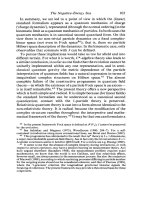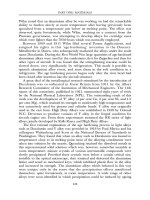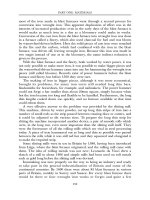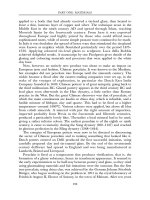An Encyclopedia of the History of Technology part 12 ppt
Bạn đang xem bản rút gọn của tài liệu. Xem và tải ngay bản đầy đủ của tài liệu tại đây (67.91 KB, 10 trang )
PART ONE: MATERIALS
92
assumed at this time most of the other responsibilities of the Cornish Metal
Company including the purchase of ore from the Cornish mines.
Arrangements for smelting this ore were made with various companies which
included the Harfords and Bristol Brass and Copper Company, and also the
Freeman Copper Company. To take advantage of the low price of coal and
improved port facilities in South Wales, Harfords at that time moved their
smelting facilities to Swansea and discontinued smelting in Bristol.
Although the Birmingham industry flourished the Bristol company
continued to decline. By 1820 smelting at the Swansea site had ceased and by
1836, when the Baptist Mills site was sold, the company was no longer a
manufacturing concern. Its remaining properties had been leased in 1833 to a
company partner Charles Ludlow Walker. In these premises, brass continued
to be made and fabricated by traditional methods until the Saltford rolling mill
stopped work in 1925 and brass making at the Avon Mill premises ceased
entirely in 1927.
Zinc in Belgium
Attempts to obtain zinc directly from calamine were being made in the Liège
district at the same time as William Champion was experimenting at Bristol.
Margraff, a somewhat legendary figure who was experimenting in 1746,
appears to have passed on his results to the Liège professor Villette. He in turn
confided the information to the Abbé Dony who introduced the first
commercially successful zinc reduction process (see Figure 1.7(c) above).
Jean Jaques Dony was born in 1759 and, having been brought up in a
brassmaking locality, he was greatly interested in the metallurgy of zinc. The
origins of the extraction process he evolved, however, are still very obscure. It
is recorded in the Biographie Liègeoise, 1836, that ‘before 21 March 1805, Dony
had succeeded in extracting metallic zinc from calamine and had managed to
melt and cast it in quantity’. In March 1806 he obtained from Napoleon an
Imperial concession to exploit a deposit of calamine at Moresnet, and in 1807
he constructed a small factory in Isle. Here, it is said, zinc was first produced in
quantity.
The limited room temperature ductility of zinc improves markedly if the
metal is warmed slightly and Sylvester and Hobson of Sheffield first
demonstrated the feasibility of producing zinc sheet by rolling at moderately
elevated temperatures in 1805. Dony produced his first sheet of zinc in January
1808 and offered it, in acknowledgement of the concession he had been
granted, to the Minister of the Interior. After 20 July 1809 high-quality zinc
was being produced in abundance, and an Imperial decree of 19 January 1810
granted Dony a patent, giving him a monopoly for the manufacture of zinc for
fifteen years.
NON-FERROUS METALS
93
Between 1810 and 1818 considerable technical advances were made in the
factory he established in the Liège suburb of Saint Leonard. Here a rolling mill
was producing zinc sheets 1.5m long by 41cm wide (59in×16in) by 1811, and
by 1813 the roof of St Paul’s Cathedral at Liège had been sheathed in zinc. In
the same year, in recognition of his Imperial patent, Dony sent to Napoleon his
bust in Zinc, a casting weighing 74kg (163lb). Between September 1809 and
February 1810 Dony had reduced the price of zinc in Liège from F8.60 to
F2.60. Like all industrial innovators, however, Dony soon begun to encounter
financial difficulties, and after 1818 he was forced to surrender all his
commercial interests to his business partner Dominique Mosselman who, in
addition to the calamine workings of Vieille Montagne, took over the entire
factory at Saint Leonard. Dony died in Liège on 6 November 1819,
Mosselman died in 1837. His heirs established the Vieille Montagne Company
which dominated the Belgian zinc industry for many years.
Champion’s vertical distillation process, which had never made zinc at a
price low enough to ensure its commercial viability, was soon superseded by
Dony’s system. Its use of massed banks of horizontal retorts reduced
considerably the quantity of fuel required. Fuel efficiency was improved even
further when double-faced furnaces were introduced. The clay condensers
emerged almost horizontally from the ends of the fireclay retorts and were
cooled by air rather than water as in Champion’s approach. Dony appears to
have stumbled, probably inadvertently, on a simple and very effective
geometry for his condenser. It is now known that the zinc vapour entering
such a condenser from the retort is subject to a great deal of convection, and
assumes a rapid revolving spiral motion round the inside of the condenser wall
before condensation to the liquid state occurs.
Soon after the Belgian process emerged, Germany, which had large deposits
of zinc ore in Silesia, developed a zinc furnace system which used retorts much
larger and stronger than those used in Belgium. This approach, which
improved both labour and fuel economy, was possible because the Silesian ore
had a coarse, porous texture which facilitated the egress of gas and zinc vapour
from deep beds of ore. The Rhenish retort subsequently developed was rapidly
adapted throughout Europe, Britain and the United States. The retort
dimensions, a compromise between those of the Belgian and Silesian systems,
were the largest which could be used for treating fine high-grade ore. In
crosssection the Rhenish retorts resembled an oval chain link, being about
18cm wide and 3ocm high (7in×12in) inside. Regenerative furnaces became
almost universal after 1900 and by 1920 fuel consumption had been reduced
to one tonne of coal per tonne of zinc distilled. Careful tests made in Swansea
in 1851 on one of the last remaining Champion vertical retort plants showed
that it required about 24 tonnes of coal to produce a tonne of zinc.
The bulk of the world’s supply of zinc was produced in horizontal retorts
until 1950. However, the process, being discontinuous, was labour and fuel
PART ONE: MATERIALS
94
intensive. The first practical continuous zinc reduction process, introduced in
the 1930s by the Imperial Smelting Corporation at Bristol, utilized a large
vertical retort built of carborundum bricks which was fed by briquettes of
roasted ore mixed with bituminous coal. The labour requirement of such
retorts was well below that of any earlier process. The output of such a unit,
around 9 tons of zinc per day, should be compared with the 60lb (27kg)
produced by the best horizontal retort of that period.
During the nineteenth century the possibility of devising an effective zinc
blast furnace attracted the attention of many ingenious metallurgists, although
little progress was made. Labour and fuel were at that time very cheap
commodities, and the world as a whole seemed content with the horizontal
retort process. This situation began to change rapidly after the First World
War. By that time profitable metallurgical enterprise had returned to the Bristol
area, and lead and zinc were being refined at Avonmouth on a large scale. The
continuous blast furnace process developed by the Imperial Smelting
Corporation took, in all, about seventeen years to develop and was not put
into production until 1957.
Like all successful and profitable innovations, the Imperial Smelting Process
depends on very simple principles. Thus, at 1000°C, the vapour pressure of lead is
negligible compared to that of zinc. It is also well known that when a bath of
molten lead saturated with zinc is cooled, the zinc thrown out of solution contains
less than 1 per cent of 1mpurities, and can be skimmed from the surface of the
melt as a virtually pure metal. The zinc blast furnace is charged with a mixture of
lead and zinc oxides which are reduced by hot coke as in a conventional iron blast
furnace. The lead and slag produced by this reaction sink to the hearth of the
furnace, where they are tapped and separated. The zinc leaves the reaction zone as
a vapour and, mixed with the carbon monoxide formed by the reduction process,
is carried into the condensing chamber where it is absorbed by streams of molten
lead. Dissolved in this way it can safely be exposed to the atmosphere without
serious risk of oxidation. The lead is then slowly cooled and the layer of pure solid
zinc which separates out on its surface is skimmed off. The remaining molten lead
is then pumped back to the condenser.
Each of these zinc blast furnaces can produce 60,000 tonnes of zinc per
year, and at least ten are in operation throughout the world.
Early applications of zinc
As a new exotic metal which had only recently become an article of commerce,
zinc was of great interest to the experimentalists of eighteenth-century Europe,
and it began to play an increasingly important role in their physical and
chemical investigations. Alessandro Volta demonstrated that the muscular
contractions observed by Galvani were caused by electrochemical potentials
NON-FERROUS METALS
95
associated with the moist contact of dissimilar metals (see Chapter 6). In one
form of his voltaic pile, silver and zinc plates were used. A cheaper and more
practical version, however, was his ‘couronne de tasses’, or crown of cups,
which used zinc and copper electrodes.
Well before this time, however, it had been noted that the behaviour of zinc
when immersed in water or aqueous solutions was very different to that of
copper, iron or lead. As early as 1742, Dr P.J.Malouin of Rouen had shown
that zinc could be substituted for tin as a corrosion-resistant coating for iron
utensils. As described by Richard Watson, Bishop of Llandaff, the coating was
applied to the surface of hammered iron saucepans by immersing them in an
iron pot filled with molten zinc, sal ammoniac being used as a flux. For a
variety of reasons galvanized iron never seriously challenged tin plate in the
manufacture of cooking utensils, and little further progress occurred until the
second decade of the nineteenth century.
In 1819 the French chemist Thenard began to appreciate that metallic
corrosion was caused by electrochemical effects. His ideas were subsequently
developed by de la Rive, who in 1830 interpreted the rapid corrosion of
impure zinc in terms of the localized electrochemical cells established between
the zinc matrix and segregated impurities. This led to the idea that corrosion
might be inhibited by coating the metallic article with a thin layer of metal
which would preferentially corrode and thus protect the substrate. Sorel
attempted to apply zinc to the surface of rolled iron sheet, and in 1837 he and
an associate named Ledru obtained a French patent for iron protected against
corrosion by a hot dipped coating of zinc. Sorel christened his new process
‘galvanizing’, in acknowledgement of the electrochemical background from
which his concept of sacrificial protection had emerged.
The English patent for galvanizing was granted in 1837 to Commander H.V.
Craufurd RN on the basis of a communication from Sorel. It was exploited by
the establishment in London in 1838 of the English, Scotch and Irish galvanised
Metal Company, which started in Southwark and shortly afterwards, as demand
increased, moved to Millwall. Many components such as iron sheets, chains,
nails and wire were treated. In 1839 a very much larger organization, the British
Galvanisation of Metals Coy, began to operate the process in Birmingham,
paying royalties to Craufurd at a rate of £3 per ton of components treated. Flat
sheets of galvanized iron 1cm thick were supplied by this company on a
considerable scale as roofing material for the new Houses of Parliament.
Galvanized corrugated iron is first mentioned in 1845 in a patent taken out
by Edmund Morewood and George Rogers. Morewood soon established
works in the Black Country, where he galvanized black corrugated iron sheet
obtained from J. and E.Walker of Gospel Oak, London. When Morewood ran
into financial difficulties in 1847, J. and E.Walker took over his plant and
equipment in part payment of debts and transferred them to Gospel Oak. The
‘G anchor O’brand of galvanized corrugated iron made at the Gospel Oak
PART ONE: MATERIALS
96
plant soon gained a world-wide reputation for its quality and reliability. Vast
quantities of galvanized iron sheet and utensils were exported to the expanding
colonies and the profits made from bursts of trade stimulated by the gold
rushes in California and Australia were very considerable. Around 1850 the
company designed and constructed a ‘beautiful Gothic villa’ constructed
completely with galvanized corrugated iron which gained much attention.
During the nineteenth century zinc sheet became a popular roofing material
in its own right, being lighter and very much cheaper than lead. Unlike
corrugated iron, zinc sheet had no structural stiffness, although when properly
applied to a suitably supporting surface it provided excellent protection. After
about 1850 zinc sheet was extensively employed for cladding the roofs of
railway stations and other buildings.
Although the hot dip galvanizing process afforded excellent protection
against corrosion, it had the disadvantage of increasing significantly the
dimensions of the articles being treated and could not, therefore, be easily
applied to the routine coating of small components such as nuts and bolts
where close dimensional control was required. Galvanizing, normally carried
out between 430° and 540°C also had a tendency to soften cold-rolled and
heat-treated components. Sherardizing, a process introduced by Sherard
Cowper-Coles between 1900 and 1904, avoided many of the disadvantages
of galvanizing. It was a cementation process, made possible by the high
vapour pressure of zinc. The steel or iron components to be treated were
packed in sealed retorts in contact with zinc dust, and heated for 4–5 hours
at about 375°C, which is well below the melting point of zinc. At this
temperature, zinc vapour soon saturated the interior surface of the retort and
diffused well below the surface of the ferrous components being treated,
providing a corrosion-resistant surface without serious change in external
dimensions. This process, which after 1904 gained rapid commercial success
on both sides of the Atlantic, is still widely employed for the treatment of
small, precise components. It has the incidental advantage of producing a
matte surface on the component which assists considerably the subsequent
adherence of paint.
THE EMERGENCE OF NICKEL
Metallic zinc was used to produce golden brasses containing less zinc than
those obtained by the calamine process. It was noted in the eighteenth century
that when zinc was added to copper in higher concentrations than those
obtainable by cementation, the alloys obtained, which were usually used for
brazing, were very much paler in colour. Some of these were confused with
another whitish alloy, paktong, which, in smaller quantities, had found its way
to Europe and Britain from the Far East since the sixteenth century. It was
NON-FERROUS METALS
97
hard, whitish in colour and, unlike the high zinc brasses, relatively ductile in
the cold condition. Being resistant to corrosion and free from the unpleasant
taste of brass it was much favoured for the manufacture of musical
instruments. Although the metal nickel had been identified by Axel Cronstedt
in 1751, the composition of paktong was unknown until 1822, when analysis
by Fyffe of Edinburgh showed that it was, in essence, an alloy based on copper,
nickel and zinc. It was then being sold in the British Isles for about 12 shillings
per lb, and was beginning to find fairly wide application as a cutlery alloy,
largely because of its white colour and resistance to corrosion.
It is uncertain when the Chinese first made paktong, although they made
extensive use of a cupro-nickel coinage as early as the first century AD. Paktong
was first mentioned specifically in the Chinese literature by Kung Ya in the third
century and a century later it was also being used for coins. Some details of the
method by which the alloy was manufactured were provided by Ho Wei in 1095.
His description does not suggest that the Chinese were then aware of the
existence of nickel as a metal in its own right, since the alloy was made by
adding small pills prepared from the ore to a bath of molten copper held in a
crucible. When a layer of slag developed over the molten metal surface, saltpetre
was added to the bath, the alloy was stirred, and the ingot was then cast. It is not
clear whether zinc was an ingredient of the pills prepared from the ore or
whether the zinc was added at a later stage. It is mentioned, however, that the
ore came from Yunan, and it seems logical to assume that it would have
contained arsenic and possibly iron in addition to the nickel. During the
eighteenth century cupro-nickel alloys in ingot form, which were sent from
Yunan to Canton, contained approximately 30 per cent nickel and 20 per cent
copper. The ingots, in the form of triangular rings about 23cm in diameter and
4cm thick (9in×1.5in), were remelted in Canton, and zinc was added until the
alloy was silvery white. During the seventeenth and eighteenth centuries,
paktong was shipped from Canton to England by the East India Company, both
in ingot form and also in the wrought condition.
It was difficult to manufacture paktong from first principles in Europe since
a suitable source of nickel had not yet been identified. Complex cobalt-
nickeliron-arsenic ores were, however, available from the Schneeburg district of
Germany, where they had been used for many years by the celebrated
Blaufarbenwerke for the manufacture of cobalt blue and other pigments for the
ceramic industry. By 1824 a Dr Geitner had devised a method of extracting
reasonably pure nickel from the waste products of the cobalt-blue process and
set up a plant for the manufacture of nickel silver which he sold throughout
Europe under the name Argentan at around three thalers a pound.
In 1829, Percival Norton Johnson arranged with Geitner to operate the
process in England. A works for purifying the crude nickel speiss from
Schneeburg was set up at Bow Common behind the Regents Park Canal in
London, and from the nickel thus obtained ingots of nickel silver
PART ONE: MATERIALS
98
containing 18 per cent Ni, 55 per cent Cu and 27 per cent Zn were
subsequently cast at Hatton Garden. Between 1829 and 1832 Johnson,
who was certainly the first man to refine nickel in the British Isles,
produced, on average, about 16.5 tonnes of nickel silver a year. Most of
this was made into cutlery, and close plated by the Birmingham
manufacturer William Hutton. The cutlery was sold under the trade name
Argentine. After 1830 several other firms began to make nickel silver and
the price of the alloy had fallen to four shillings a pound. Johnson’s most
serious competitor was the Birmingham firm of H. & T.Merry, which was
managed by Charles Askin and Brook Evans, the technical operations
being in the hands of a very ingenious chemist, Dr E.W.Benson, who
devised greatly improved methods of cobalt and nickel separation. Around
1832, H. & T.Merry changed its name to Evans & Askin and marketed a
brand of nickel silver known as British Plate.
Nickel silver made in Europe was generally known as Neusilber or
Argentan. The common designation in England was German Silver, although
it was also known as nickel silver, Argentine, Albati, and British Plate.
The world’s consumption of nickel in 1850 was approximately 100 tonnes
per annum, most of this being obtained from small arsenical nickel deposits
such as those at Schneeburg and Dillenberg. Usage of the metal increased
slowly, until 1889 when the invention of nickel steels by James Riley of
Glasgow created a demand which was difficult to satisfy. The nickel pyrrhotite
deposits of Norway produced about 4600 tonnes of nickel between 1848 and
1907. This output was small, compared to that of the garnierite deposits of
New Caledonia, which were discovered in 1865. These deposits, which
contained initially 10–12 per cent of nickel, produced ore and mattes
equivalent in total to approximately 165,000 tonnes of metallic nickel between
1875 and 1915. By 1920 the nickel deposits of the island of New Caledonia
were virtually exhausted.
The famous nickel deposits of Sudbury, Ontario, are like those of Norway
based on nickel pyrrhotite, although the ore is richer and more extensive. They
were discovered in 1883 when cuttings were being made for the Canadian Pacific
Railway. The next major nickel deposit to be uncovered was the Merensky Reef,
near Rustenburg, in South Africa. Since its discovery in 1924 this has become one
of the world’s major sources of nickel and some of the less common metals. Very
large cupro-nickel deposits in the north-western province of Gansu in China were
discovered in 1958, and this area, where mining has developed rapidly since 1965,
might well become a major source of nickel in future years.
The world’s usage of nickel increased slowly in the second half of the
nineteenth century. Several European governments were attracted to the
use of nickel silver as a coinage alloy, but were deterred initially by the
difficulty of reconciling the nominal and actual values of the metals from
which the coins were composed. Switzerland, which introduced a nickel
NON-FERROUS METALS
99
silver ‘billon’ coinage in 1850, solved this problem by including specified
quantities of silver in the alloys used for the various denominations. In
1879 the silver content was omitted and Switzerland adopted the 75:25
copper-nickel alloy which was already being used by Belgium, the United
States and Germany.
In the years which followed the introduction of pure unalloyed nickel as a
marketable commodity, it came to be regarded as a metal which was difficult
to melt, cast and fabricate. Although no serious problems were encountered in
melting the metal in the coke-fired pot furnaces usually employed for melting
carbon steel, the ingots obtained were often too brittle to be worked either hot
or cold. Sometimes it was found that an ingot would crumble into fragments
when hot working was attempted, whereas other ingots from the same batch
could be cold rolled.
This problem, which seemed to be analogous to the hot shortness of
Bessemer steel (see p. 167) was solved by adding spiegeleisen, an alloy of iron,
manganese and carbon, to the melt, although this addition had a deleterious
effect upon the corrosion resistance of the nickel sheet produced and it became
necessary to use pure manganese. In the Birmingham works of Henry Wiggin
& Co, nickel wire being produced in 1880 required between 1.5 and 3.0 per
cent manganese to ensure ductility. The standing melting procedure at that
time was to reduce the carbon content of the melt to about 0.10 per cent by
additions of nickel oxide, and then to complete the scavenging process by
adding manganese in concentrations up to 3 per cent.
By that time it had been found by Thomas Fleitman and other workers in
the United States that magnesium was far more effective than manganese in
improving the ductility of nickel and that lower concentrations were required.
The use of magnesium as a scavenger was confined initially to the United
States until 1924 when the mechanism responsible for the variable ductility of
nickel and its alloys was elucidated by Paul Merica and his co-workers at the
National Bureau of Standards in Washington. They were able to show that
nickel was embrittled not by oxygen but by sulphur contamination of anything
above 0.005 per cent. The secret of success was to treat the molten nickel with
a metal such as magnesium which has a higher affinity than nickel for sulphur.
Any excess magnesium not required for desulphurization removed itself by
evaporation from the melt.
Claims to most of the significant ore bodies in the Sudbury district had been
established by numerous prospectors, mining engineers and small companies
soon after the initial discovery of ore in 1883. By 1886 most of the metallurgical
assets had been acquired by the Canadian Copper Company under the
leadership of S.J.Ritchie. This company shipped most of its roasted ore to the
Orford Copper Company of Bayonne, New Jersey, for refining. Difficulties were
encountered, however, in extracting the nickel since no satisfactory method
existed at that time for separating the constituents of a copper iron nickel matte.
PART ONE: MATERIALS
100
By 1891, however, John L.Thomson, the Superintendent of the Orford Copper
Company, had devised an elegant method of extracting nickel from the Sudbury
ore. He utilized the ability of nitre cake, or acid sodium sulphate, to split up the
molten copper nickel matte into two distinct layers. The copper-sodium sulphide,
being lightest, separated into the upper layer, while the bottom layer contained
nearly all the nickel in the matte. When the molten matte, thus treated, was
allowed to cool very slowly in large pots, the two layers separated very sharply.
Thus was born the celebrated ‘tops and bottoms’ process. The tops were
transferred to convertors and blown to blister copper. The bottoms were roasted
to remove all sulphur. The black nickel oxide remaining was then reduced to
metallic form in an open hearth furnace, from which ingots suitable for
electrolytic refining were cast.
The patent covering the Orford process was filed in May 1891, Thomson’s
assistant C.C.Bartlett being named as the inventor. Two years earlier, however,
a very much simpler method of extracting nickel from cupro-nickel ores had
been discovered in London by Ludwig Mond. After settling in London at the
age of twenty-three, Mond had become deeply involved in the world of the
chemical industry and in his forties had established the industrial empire of
Brunner Mond & Co. In the early 1880s he set up a private research
laboratory at his London home, and here, in October 1889, his young
Austrian research colleague Carl Langer, who had been heating finely divided
nickel in a tube furnace under a current of carbon monoxide, became aware of
a remarkable effect. The colour of the carbon monoxide flame, burned at a jet
as it left the furnace tube, changed from blue to a sickly green colour when the
temperature of the nickel in the furnace fell somewhat below that of the boiling
point of water.
Mond was immediately called to see this strange effect, and found that a
nickel mirror was deposited on the surface of a white porcelain tile thrust into
the flame. It was soon demonstrated that the gas leaving the furnace contained
a hitherto unknown volatile compound of nickel which was named nickel
carbonyl. It was found to form when carbon monoxide contacted pure nickel
below about 110°C and to decompose above 180°C, when pure nickel, free
from carbon was deposited, Mond appreciated very quickly that carbon
monoxide gas could very well be the ideal leachant for selectively removing
nickel from the Sudbury ores. By 1892 he had demonstrated the effectiveness
of this approach in removing nickel from most types of ore in his London
laboratory, and by the end of that year he had established a large-scale pilot
plant at Smethwick, near Birmingham, on land belonging to Henry Wiggin.
This plant was soon extracting nickel from the Canadian ore at a rate of about
1400kg (3080lb) a week.
By the end of the century the Mond Nickel Company had been established,
and had acquired the Garson and Levack Mines in the Sudbury nickel
complex. By that time the Canadian Copper Company, united with its former
NON-FERROUS METALS
101
allies and associates such as the Orford Copper Company, had transformed
itself into the International Nickel Company and had transferred its refining
operations from New Jersey to Port Colborne, Ontario, where nickel was
extracted from the matte by the Orford process. By 1921 the International
Nickel and the Mond Nickel Companies were the only two organizations
treating the Sudbury ores. Mond Nickel had a smelter at Coniston from which
the matte was shipped to Clydach in South Wales for refining by the carbonyl
process. Carbonyl nickel as originally produced at this plant contained less
than 0.05 per cent metallic impurities, and since 1900 has been the purest
grade of nickel commercially available.
In 1905, fourteen years after the Orford process had been introduced, it
was suggested by Robert Stanley of International Nickel that if the copper
nickel iron converter matte then being received by the refinery was converted
directly to metallic form instead of being laboriously separated into its
constituents, it would yield a ductile, corrosion-resistant cupro-nickel alloy
which could be of considerable value to the chemical industry. Monel metal
was named after Ambrose Monell, at that time president of the International
Nickel Company. It contained approximately 67 per cent nickel, 28 per cent
copper and 5 per cent iron plus manganese. In this natural alloy the copper
and nickel retained the same relative proportions as in the converter matte.
The iron also came directly from the matte, the only intentional addition
being the manganese which was incorporated to remove the last traces of
sulphur from the alloy.
Monel metal is still widely used where a ductile corrosion-resistant alloy is
required. In its colour, mechanical properties and ductility it resembles nickel,
and it is resistant to anhydrous ammonia, sea water and a wide range of
organic chemicals. It is used for marine propellers and much marine hardware
and at one time was used for roofing train sheds and railway stations in the
United States. Between the two world wars it was also used extensively for the
manufacture of kitchen sinks and for the heads of golf clubs. From such
applications it has been largely displaced by austenitic stainless steels which are
significantly cheaper.
The Orford process was not superseded until 1950 when it was found that
the converter matte, when allowed to solidify in its equilibrium condition,
crystallized as a mechanical mixture of the copper and nickel phases. These
were separated by crushing the matte to a fine powder from which the nickel-
rich phase was removed by magnetic and flotation processes.
The International and Mond Nickel Companies have now combined their
resources, and the nickel oxide produced by the new Inco refining process is
turned into metallic form either by electrolytic refining or by the carbonyl
process. Monel metal, for reasons of control and economy, is no longer a
natural alloy, but is produced by alloying copper, nickel and iron together in
the desired proportions.









